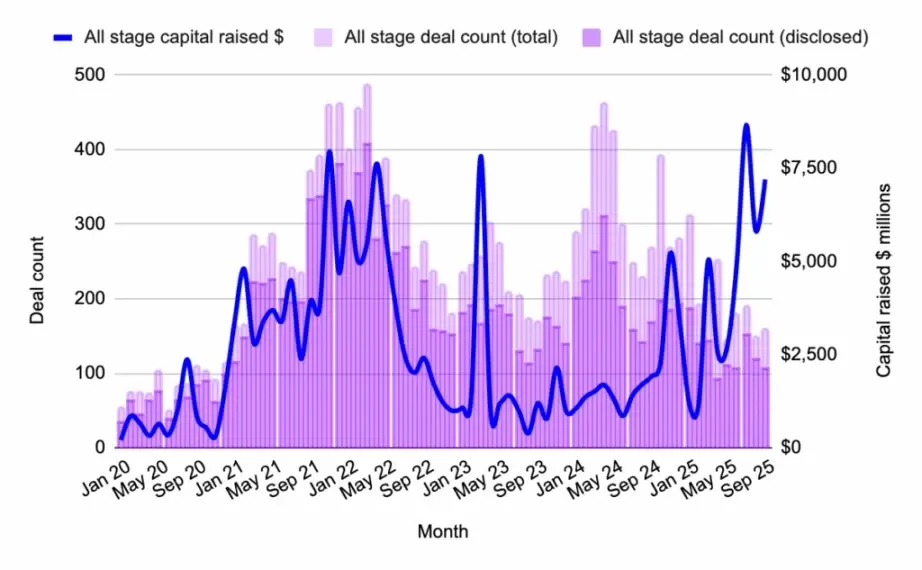Author: Carbon Chain Value
On October 28, according to the WSJ, Federal Reserve officials will face a sudden and urgent decision during their meeting this week, unrelated to interest rate cuts: whether to stop reducing the central bank's $6.6 trillion asset portfolio in a few days or wait until the end of the year to make that decision.
Just two weeks ago, the Federal Reserve seemed to be proceeding with its year-end decision as planned. Federal Reserve Chairman Jerome Powell made a rare speech focusing primarily on the technical aspects of monetary policy, stating that the Fed may face a situation in the "coming months" where it needs to end its three-year-long asset reduction efforts.
However, analysts have indicated that since then, pressures in the overnight funding market have been greater than expected, potentially necessitating an earlier halt.
The debate over when to stop the balance sheet reduction is distinctly different from the discussions expected this week regarding maintaining stable interest rates or cutting rates. Instead, the core of these discussions is how best to ensure the Federal Reserve maintains effective control over short-term interest rates.
The Federal Reserve expanded its massive portfolio (sometimes referred to as its balance sheet) during the 2007-2009 financial crisis and again purchased large amounts of government debt and mortgage-backed securities during the pandemic to stabilize markets and stimulate the economy.
Since the balance sheet size peaked at nearly $9 trillion in 2022, Federal Reserve officials have been gradually reducing the balance sheet by allowing securities to mature without replacement. When the Fed purchases securities, it creates reserves—i.e., electronic cash that banks hold at the central bank. When securities mature, this electronic money flows out of the financial system.
Federal Reserve officials do not want the balance sheet to be too large, as providing trillions of dollars in interest-bearing reserves to the banking system carries political costs, such as paying banks substantial interest. However, officials also need to control short-term interest rates. If rates unexpectedly rise, their volatility could affect mortgage rates, commercial loans, and the flow of credit in the economy.
Officials lack experience with the delicate process of reducing the balance sheet. Just like a driver searching for an exit ramp on an unfamiliar highway, if they wait too long, officials risk missing the exit. Doing so would only recreate a situation that Federal Reserve leaders have been trying to avoid: in September 2019, the Fed inadvertently used too much reserve, causing overnight lending rates to spike. Officials hurriedly executed a confusing 180-degree turn, injecting cash back into the financial system.
For the past three years, most of the funds for the Fed's balance sheet reduction have not come from banks but from a separate deposit tool that money market funds can use to park cash. The size of this tool has fallen from a peak of over $2.2 trillion in 2023 and is now nearly empty. With this buffer disappearing, every dollar on the Fed's balance sheet now comes directly from bank reserves.
In the days following Powell's speech on October 14, as the government issued new debt and withdrew cash from the banking system, overnight rates strengthened—equivalent to a large withdrawal by a major government client. These funding pressures have pushed the Fed's benchmark federal funds rate up within the target range of 4% to 4.25%, indicating that reserves in the banking system are becoming less freely available.
The pressure briefly eased but re-emerged last week, coinciding with a period when mortgage-related cash flows typically suppress rising money market rates. Banks have been more frequently utilizing a Fed lending tool designed to act as a safety valve, allowing them to exchange securities for reserves, further indicating that reserves are becoming less abundant.
When Federal Reserve officials began reducing the balance sheet in 2022, they agreed to stop the reduction when reserves were "slightly above" the level needed for smooth market functioning.
Lou Crandall, chief economist at research firm Wrightson ICAP, stated that the Fed's current policy framework is designed to detect recent market signals indicating that the Fed is approaching its possible reserve level decline target. "The proximity alarm is sounding in the cockpit," he said.
The Fed has slowed the pace of balance sheet reduction twice, most recently in April, reducing about $20 billion in securities per month.
Blake Gwinn, head of U.S. interest rate strategy at RBC Capital Markets, stated that continuing to reduce the balance sheet for a few more months might indicate that the central bank is not worried about recent volatility.
"They can continue to drag it out, but I personally think it should have stopped six months ago," Gwinn said. "There is almost no benefit to doing so, while the risk of increased volatility in the overnight lending market does indeed rise slightly."
Currently, the Fed allows up to $35 billion in mortgage-backed securities and $5 billion in U.S. Treasury bonds to be reduced from its portfolio each month. Since officials have indicated that once the reduction ends, they want to keep only U.S. Treasuries on the balance sheet, they may continue to reduce mortgage-backed securities and invest the proceeds from all maturing bonds into U.S. Treasuries.
At least one Federal Reserve official has suggested a preference for allowing the balance sheet reduction to continue for a longer period. Federal Reserve Vice Chair for Bank Supervision Michelle Bowman indicated in a speech in September that she prefers to set a smaller long-term balance sheet target than outlined in the 2022 principles to minimize the Fed's influence in the market and improve the ability to interpret market pressure signals.
Federal Reserve Governor Christopher Waller, who voted against the decision to slow the pace of Treasury bond reductions in March, defended the current operational framework in a moderated discussion this month. He stated, "We are at a juncture where banks must compete for reserves."
The current framework wisely ensures that "people do not have to rummage through their couches for change at the end of the day to fill their reserves. In my view, that is foolish behavior," he said.
After deciding when to stop the portfolio reduction, officials will face other decisions, including when to allow it to grow again and which assets to purchase. The Fed's assets (primarily U.S. Treasuries and mortgage bonds) are countered by liabilities, including reserves, U.S. Treasury cash accounts, and physical currency.
Even if the Fed stops reducing assets, any growth in non-reserve liabilities will lead to a corresponding decline in reserves. As a result, officials will ultimately have to decide when to resume purchasing securities to prevent reserves from being passively reduced further.
免责声明:本文章仅代表作者个人观点,不代表本平台的立场和观点。本文章仅供信息分享,不构成对任何人的任何投资建议。用户与作者之间的任何争议,与本平台无关。如网页中刊载的文章或图片涉及侵权,请提供相关的权利证明和身份证明发送邮件到support@aicoin.com,本平台相关工作人员将会进行核查。




